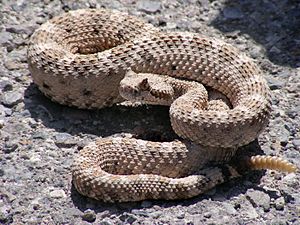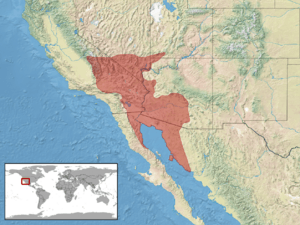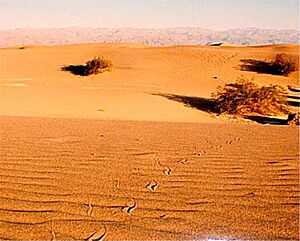Sidewinder facts for kids
Quick facts for kids Sidewinder(Crotalus cerastes) |
|
|---|---|
 |
|
| Death Valley National Park | |
| Conservation status | |
| Scientific classification | |
| Genus: |
Crotalus
|
| Species: |
cerastes
|
 |
|
| Synonyms | |
The sidewinder (Crotalus cerastes) is a type of rattlesnake found in the deserts of the Southwestern United States and northwestern Mexico. It is also known as the horned rattlesnake because of its unique scales above its eyes. Like all rattlesnakes, it is a venomous animal. There are three main types, or subspecies, of sidewinders.
Contents
What is a Sidewinder?
Size and Appearance
Sidewinders are small snakes. Adult sidewinders usually grow to be about 43 to 76 centimeters (17 to 30 inches) long. Most adults are between 50 and 80 centimeters (20 to 31 inches) long. Female sidewinders are often a bit larger than males, which is not common for this group of snakes.
They have special scales that are rough, called keeled scales, along their back. The most noticeable feature is the raised scales above their eyes, which look like little horns. These "horns" might help shade their eyes from the bright sun or keep sand out of their eyes when they are buried.
Their skin color helps them blend in with the desert. It can be cream, yellow-brown, pink, or gray. They have darker blotches on their backs that help them hide.
Where Sidewinders Live
Sidewinders live in the desert areas of the Southwestern United States. This includes parts of southeastern California, southern Nevada, southwestern Utah, and western Arizona. In northwestern Mexico, they are found in western Sonora and eastern Baja California.
Conservation Status
The sidewinder is listed as a species of "least concern" by the IUCN Red List. This means that their population is stable and they are not currently at risk of disappearing. They are found over a wide area and have a large population.
How Sidewinders Behave

Sidewinding Movement
The sidewinder gets its name from its special way of moving. It uses a unique movement called "sidewinding." This helps it move quickly and get good grip on loose desert sand. When a sidewinder moves, it leaves a J-shaped track in the sand. The hook of the "J" points in the direction the snake is going. Other desert snakes also use this movement. Sidewinders can even use sidewinding to climb sandy hills without slipping.
Daily Activity
Sidewinders are active at different times depending on the temperature. When it's hot, they are mostly active at night (nocturnal). When it's cooler, they are active during the day (diurnal). Their active period is usually from November to March.
Hunting and Diet
Young sidewinders have a clever way to catch food. They wiggle their tails to attract lizards, a behavior called "caudal luring." As they grow older, they stop doing this. Adult sidewinders mainly eat desert rodents, birds, and other snakes.
Baby Sidewinders and Their Burrow
Baby sidewinders show a unique behavior to stay warm. After they are born, they gather together in their burrow. The mother snake usually chooses a small, east-facing burrow to give birth. For about a week, the baby snakes block the entrance of the burrow during the day. They form a moving group that uses the warm outside air and the cool inside of the burrow to keep their bodies at a good temperature (around 32°C or 90°F). This group behavior helps them survive in temperatures that would be too hot for a single baby snake.
Sidewinder Life Cycle and Reproduction
Giving Birth
Female sidewinders can have up to 18 babies at a time, but they usually have about 10. Like most viper snakes, the babies are born inside a thin membrane, which they break out of soon after birth. The young snakes stay with their mother in the burrow for about 7 to 10 days. During this time, they shed their skin for the first time. After shedding, they leave the burrow and are on their own. The mother is thought to protect them during this early period.
Mating and Growth
Sidewinders become old enough to have babies when they are 2 to 3 years old. They can have babies every year, but some females might skip a year or two if there isn't enough food. Sidewinders usually mate in April and May, and sometimes in the fall.
During mating, the male snake crawls over the female, rubbing his chin on her to get her attention. He then wraps his tail around hers, trying to bring their cloacae together. The cloaca is the opening at the end of a snake's body used for waste and reproduction. If the female is ready, she lifts her tail. They can mate for several hours. Females might mate with more than one male.
Babies are born in late summer to early fall and are about 15 to 20 centimeters (6 to 8 inches) long. The birth process takes only 2 to 3 hours.
Lifespan
In the wild, female sidewinders usually live for about 5 years. Males can live longer, sometimes up to 13 years. In zoos or with good care, sidewinders can live for more than 20 years. This suggests that finding enough food is very important for how long females live in the wild. Predators, diseases, and cars can also shorten their lives.
Sidewinder Venom
Sidewinders are venomous, but their venom is not as strong as that of some other rattlesnakes. They also have smaller venom glands. This makes them less dangerous than larger rattlesnakes. However, any rattlesnake bite can be serious and needs immediate medical attention.
A sidewinder bite can cause pain, swelling, and bruising. The swelling might spread to an entire arm or leg. Other symptoms can include feeling sick, dizzy, chills, and blood problems. There is an antivenom available to treat rattlesnake bites. If someone is bitten, it's important to get help from a doctor or a poison control center right away.
Types of Sidewinders (Subspecies)
| Subspecies | Taxon author | Common name | Geographic range |
|---|---|---|---|
| C. c. cerastes | Hallowell, 1854 | Mojave Desert sidewinder | Found in the desert areas of the United States, from northeastern Los Angeles County and San Bernardino County, California, north to southern Mono County, California, east across Nevada to Washington County, Utah, and south through La Paz County, Arizona. They live in desert lowlands between 152 and 1,829 meters (500 and 6,000 feet) high. |
| C. c. cercobombus | Savage & Cliff, 1953 | Sonoran Desert sidewinder | Found in the United States from Yuma, Maricopa, Pima, and Pinal Counties in Arizona. They also live south into Sonora, Mexico. |
| C. c. laterorepens | Klauber, 1944 | Colorado Desert sidewinder | Lives in the desert areas of the United States from central and eastern Riverside County, California, to Pinal County, Arizona. It also lives south to northwestern Sonora in Mexico, and northwest to northeastern Baja California, from the Colorado River to the desert foothills at elevations between 152 and 610 meters (500 and 2,000 feet). |
See also
 In Spanish: Crotalus cerastes para niños
In Spanish: Crotalus cerastes para niños


